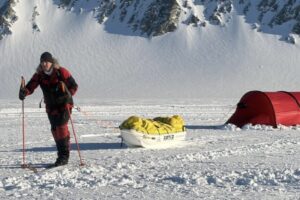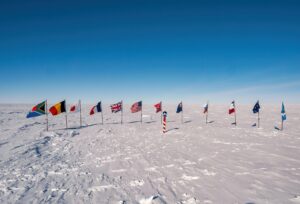The Second Seven Summits, the less-known and more difficult little brother of the Seven Summits, involves climbing the second-highest peak on each continent. In Antarctica, this means Mount Tyree, a 4,852m peak with only a smattering of ascents.
No bears
The name Antarctica comes from the Greek word arktos, meaning “bear”. Antartikos means “no bears”, an accurate description of the southern continent.

Mount Tyree. Photo: Wikipedia
The geological history of Antarctica began about 25 million years ago, with the gradual breakup of the supercontinent of Gondwana. Initially, Antarctica was further north and had a temperate or tropical climate. Then came the Ice Ages of the Pleistocene, which spread across the continent, wiping out its flora and fauna.
Geologically, West Antarctica resembles the Andes. East Antarctica is higher, and a thick ice sheet covers the central plateau.

Antarctica and its mountain ranges. Photo: MountainIQ
The continent has three main mountain ranges. The Antarctic Peninsula Cordillera runs the full length of the Antarctic Peninsula. Further south lies the Ellsworth Mountains. Finally, the Transantarctic Mountains run north to south, splitting the continent into East and West Antarctica.
The Ellsworth Mountains are the highest range in Antarctica. It runs 360km from north to south beside the Filchner-Ronne Ice Shelf and is 48km wide. The Minnesota Glacier bisects the Ellsworth Mountains. The northern half is called the Sentinel Range, and the southern half is the Heritage Range.

The Sentinel Range. Photo: MountainIQ
Australian Antarctic mountaineer Damien Gildea described the Sentinel Range in his book, Mountaineering in Antarctica –- Climbing in the Frozen South:
“The Sentinel Range stretches for almost 200km like a long, jagged spine, with numerous rocky ridges shooting out to the side and sweeping down to the ice, unusually uniform in their appearance and spacing. In between these ridges lie many couloirs and big, mixed faces, some rising over 2,000m above the flat ice stretching out east and west.”

Some of the big mountains in the Sentinel Range. Photo: John Evans
Climbing history
The Sentinel range includes some of the highest mountains in Antarctica, including the highest, Mount Vinson (4,892m), and the second-highest, Mount Tyree (4,852m).
On November 23, 1935, American aviator Lincoln Ellsworth flew over the mountains but clouds so obscured them that he could only spot only one small peak (2,775m). He named it after his wife, Marie Louise Ulmer.

The south face of Mount Epperly. Photo: The Seven Summits Club
Antarctica’s highest mountains remained almost completely unknown until the 1950s when the U.S. began mapping them. In 1957, a U.S. Navy flight spotted the peaks of the Vinson Massif. In January 1958, the U.S. Navy’s VX-6 Squadron noted Mount Tyree.
The first measurements took place in 1959. Climbing itself only started in December 1961, when two American scientists, John Splettstoesser and Tom Bastien, visited the far northern end of the Sentinel Range.
Between 1963 and 1964, more exploration occurred around the Union Glacier, but no significant climbs were carried out until 1966.
The climbing season falls during the Antarctic summer, from December to February.

Mount Gardner (4,573m), from the southwest. Photo: Christian Stangl
The first ascent of Mount Vinson
A U.S. team led by Nick Clinch first climbed Mount Vinson on December 18, 1966. The four successful climbers were Barry Corbet, Bill Long, John Evans, and Pete Schoening. In the following days, the rest of the nine-man team also summited. They continued to explore the mountains in the area and made first ascents on five other mountains too, among them, Mount Tyree.
Mount Vinson has several routes, an interesting climbing history, and several high-quality ascents, but it is also now something of a tourist peak. It is a required climb for those aiming to complete the Seven Summits.

The northeast ridge of Mount Tyree. Photo: Antarctic Logistics
Tyree vs. Vinson
As with Mount Kenya and Kilimanjaro, Antarctica’s second-highest peak is trickier than its highest.
Neither Mount Vinson nor Mount Tyree is difficult just because of the height. Rather, the harsh climate is the biggest challenge. Climbers who have done both say that Mount Tyree is more difficult in the upper sections, requiring technical climbing. Access and logistics are also more difficult for Mount Tyree.
As a result, Mount Tyree has only 16 to 20 ascents, while Mount Vinson has more than 1,000.

Just below the summit of Mount Tyree, 1967. Photo: John Evans
The first ascent of Mount Tyree
Mount Tyree is less than 15km northwest of Vinson. It has a prominence of 1,152m and is surrounded by the Patton Glacier to the north and the Cervellatti Glacier to the southeast.
Barry Corbet and John Evans first climbed Tyree on January 6, 1967, via the Tyree/Gardner Col.

Spectre (2,020m) is a prominent rock spire in the Gothic Mountains. Mugs Stump climbed this remote spire in 1980 from the north side. Top photo: Mugs Stump. Bottom photo: Leo Houlding
Mugs Stump
American rock climber Terry “Mugs” Stump was one of the best rock climbers and mountaineers of his time. He made several difficult first ascents in the Canadian Rockies and Alaska, but his love for Antarctica was something special. Under contract with the National Science Foundation, he worked as a safety consultant and guide during four trips to the continent.
In 1989, Stump made the second ascent of Mount Tyree. Probably the mountain’s most spectacular climb, Stump ascended over 2,300m via the dreaded west face. He climbed solo. On the summit, he found a pennant left by the first ascent team.
He descended via the original 1967 Corbet-Evans route along the northwest ridge and continued down, over a total of 12 hours. It was “perhaps the hardest route yet accomplished by man,” he later recalled.

John Evans on the summit of Mount Tyree, January 6, 1967. Photo: Barry Corbet/John Evans Collection
Despite this grandiose pronouncement, Stump did not normally like to talk about his climbs with the press. But he would recount his exploits to friends.
“I recall Mugs’ wild eyes as he recounted his climbs to me, many degrees of latitude away, over a cup of tea,” recalled climber Conrad Anker.
For him, Stump, who died in 1992 on Denali, was much more than an excellent climber: “He taught me the joy of mental toughness, the ease of hard climbing, and something about a way of life,” Anker said.

The east face of Mount Tyree in semi-profile. Photo: Damien Gildea
Other ascents
In November 1997, French climbers Antoine de Choudens and Antoine Cayrol climbed Mount Tyree via the Great Couloir (east side). They ascended the lower section of the northeast ridge, before traversing into the upper couloir on the northeast face. All subsequent ascents of Tyree have used this route.
In 1997, Conrad Anker and Alex Lowe climbed Tyree via the Great Couloir.
On January 3, 2012, Tyree was climbed by Hans Kammerlander, Robert Miller, and Christian Stangl, again via the Great Couloir. Kammerlander and Stangl were working on their Second Seven Summits project, which we will detail in a future story.

Conrad Anker on the summit of Mount Tyree. Photo: Conrad Anker
On January 16, 2017, five climbers made the sixth ascent of Mount Tyree, in honor of the 50th anniversary of the first ascent. The team included Richard Thurmer Jr, Victor Saunders, Maria Paz Ibarra, Seth Timpano, and Todd Tumolo. The team climbed the Great Couloir.
Saunders became the oldest climber to summit Tyree (he was 66 at the time) and Ibarra became the first woman.
Its most recent ascent was by Jennifer Drummond and her guides. On January 1, 2022, Drummond became the second woman and first U.S. woman. Drummond is also working on the Second Seven Summits.
“While the ridge was sharp and steep, the views were endless in all directions,” she said after her 18-hour slog. “It was also fun to see Mount Vinson.”
A final challenge
The 2,000m+ south face of Mount Tyree remains unclimbed and is one of the largest walls in Antarctica.

The huge, unclimbed south face of Mount Tyree is one of the greatest unclimbed objectives on the continent. Photo: Damien Gildea




